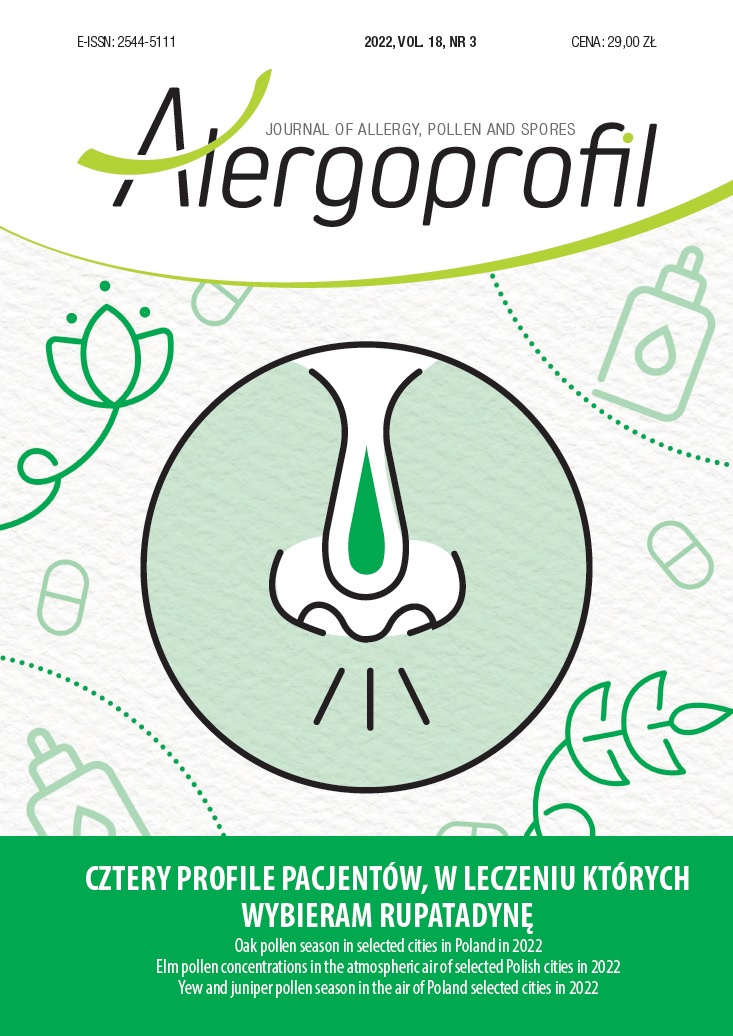Elm pollen concentrations in the atmospheric air of selected Polish cities in 2022 Original article
Main Article Content
Abstract
The elm (Ulmus sp.) is one of the early spring flowering trees. The aim of the study was to compare the elm pollen season in selected Polish cities in 2022. The aeropalynological measurements were carried out with the volumetric method. The study was focused on determination of the total daily pollen grain concentrations during the season, the beginning and end of the pollen season (determined using the 95% method), the peak pollen concentrations, and the dates with maximum pollen concentrations. The earliest onset of the elm pollen season was noted in Sosnowiec (March 9th). In turn, the latest onset was recorded in Lublin (March 23th). The pollen season lasted from 18 days (in Cracow) to 37 days (in Sosnowiec). The highest total daily pollen grain concentrations and the highest maximum concentration were recorded in Cracow (1202 and 321 P/m3, respectively), whereas the lowest values of these parameters were noted in Bialystok (72 and 9 P/m3, respectively). In most of the analyzed cities, the peak pollen concentration was recorded between March 25th and 29th.
Downloads
Article Details

This work is licensed under a Creative Commons Attribution-NonCommercial 4.0 International License.
Copyright: © Medical Education sp. z o.o. This is an Open Access article distributed under the terms of the Attribution-NonCommercial 4.0 International (CC BY-NC 4.0). License (https://creativecommons.org/licenses/by-nc/4.0/), allowing third parties to copy and redistribute the material in any medium or format and to remix, transform, and build upon the material, provided the original work is properly cited and states its license.
Address reprint requests to: Medical Education, Marcin Kuźma (marcin.kuzma@mededu.pl)
References
2. Szafer W, Kulczyński S, Pawłowski B. Rośliny polskie. PWN, Warszawa 1988.
3. Borkowski K, Tomusiak R, Zarzyński P. Drzewa Polski. PWN, Warszawa 2016.
4. Lipiec A, Puc M, Kruczek A. Exposure to pollen allergens in allergic rhinitis expressed by diurnal variation of airborne tree pollen in urban and rural area. Otolaryngol Pol. 2019, 74(5): 1-6. http://doi.org/10.5604/01.3001.0013.1532.
5. Miguel AG, Taylor PE, House J et al. Meteorological influences on respirable fragment release from chinese elm pollen. Aerosol Sci Technol. 2006, 40: 690-6. http://doi.org/10.1080/02786820600798869.
6. Chico-Fernández J, Ayuga-Téllez E. Analysis of pollen concentrations from various tree pollen types and their interrelation with different airborne pollutants in the Madrid region (Spain). Sustainability. 2022, 14(9): 5259. http://doi.org/10.3390/su14095259.
7. Andersen TB. A model to predict the beginning of the pollen season. Grana. 1991; 30: 269-75. http://doi.org/10.1080/00173139109427810.
8. Galán C, Ariatti A, Bonini M et al. Recommended terminology for aerobiological studies. Aerobiologia. 2017; 33: 293-5.
9. Geller-Bernstein C, Portnoy JM. The Clinical Utility of Pollen Counts. Clin Rev Allergy Immunol. 2019; 57(3): 340-9. http://doi.org/10.1007/s12016-018-8698-8.

